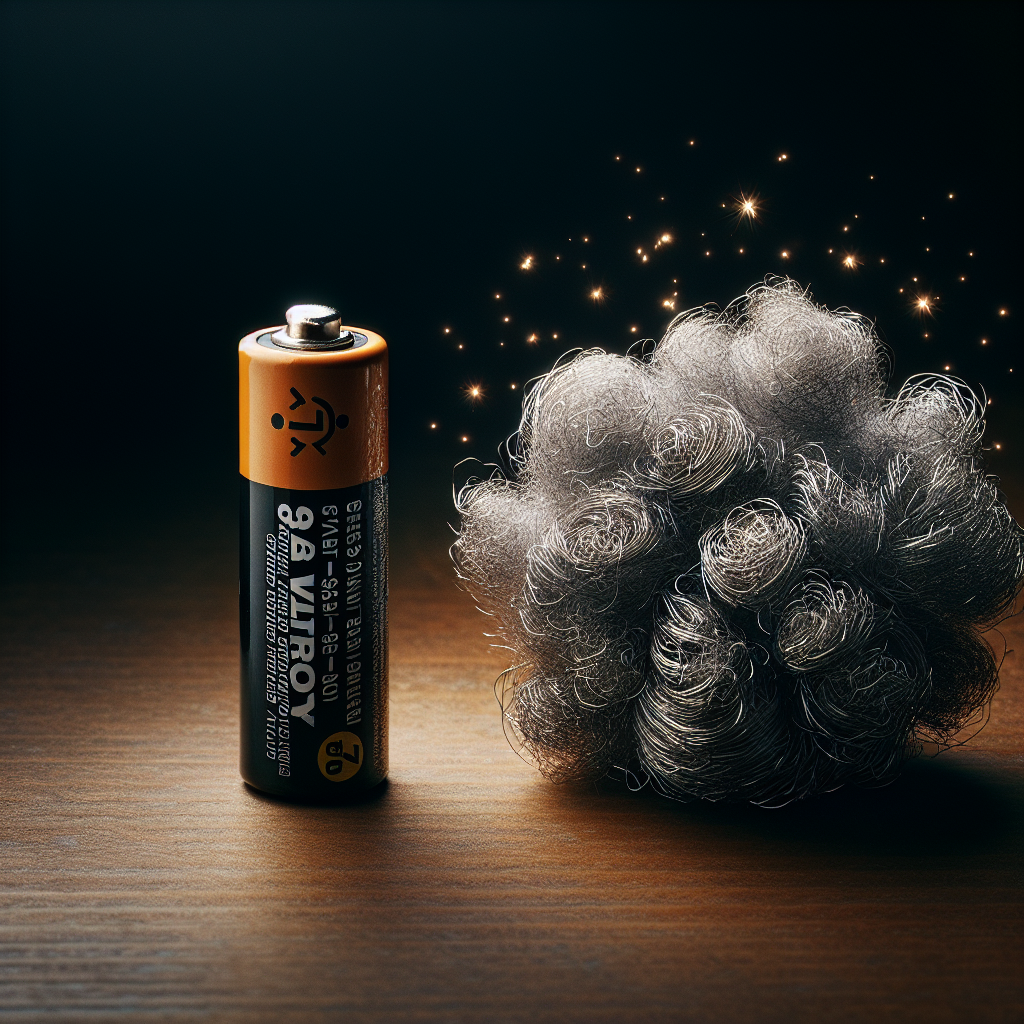Ever wondered, “How To Start A Fire With A Battery And Steel Wool?” In this article, we demystify this survival skill. Be it for camping, power outages, or to wow your friends with your expertise, this technique is essential.
We provide step-by-step instructions to effectively ignite a fire using just these simple tools. So grab your battery and steel wool, let’s dive into learning this exciting survival skill!
Choosing the Right Battery
When it comes to starting a fire with a battery and steel wool, it is important to choose the right type of battery. The two most commonly used types of batteries for this purpose are AA batteries and 9-volt batteries.
AA batteries are a popular choice due to their size and availability. They are commonly found in households and are relatively inexpensive. However, one downside to using AA batteries is that they have a lower voltage compared to 9-volt batteries. This means that they may produce weaker sparks when used with steel wool.
On the other hand, 9-volt batteries are known for their higher voltage, which makes them ideal for starting fires with steel wool. They can create stronger sparks, increasing the chances of successfully igniting the steel wool. However, 9-volt batteries are typically larger and less common in households compared to AA batteries.
Ultimately, the choice between AA batteries and 9-volt batteries depends on your personal preference and what is readily available to you. Both types can be used effectively, but keep in mind that 9-volt batteries may produce stronger sparks.
Preparing the Steel Wool
Before you can start a fire using a battery and steel wool, it is important to properly prepare the steel wool. This involves selecting the right grade of steel wool and removing any packaging or debris.
Selecting the Steel Wool Grade
Steel wool comes in different grades, ranging from extra fine to extra coarse. The grade you choose will depend on the desired intensity of the sparks you want to create. Finer grades of steel wool, such as 0000 or 000 grades, tend to produce finer sparks, while coarser grades, such as 0 or 1 grades, produce larger sparks.
If you are looking for a more intense spark that can easily ignite the steel wool, then a coarser grade may be more suitable. However, if you are concerned about safety or want a more controlled ignition, a finer grade is recommended.
Removing Packaging and Unraveling the Wool
Once you have selected the desired grade of steel wool, it is important to remove any packaging or plastic wrappers that may be present. These materials can potentially melt and cause a fire hazard when exposed to heat or sparks.
After removing the packaging, unravel the steel wool to create a larger, more spread-out surface area. This will allow the sparks to catch and ignite the steel wool more easily. Make sure there are no clumps or knots in the steel wool as this can inhibit the ignition process.
Creating the Fire Platform
To safely start a fire using a battery and steel wool, it is crucial to create a fire platform. This platform will serve as the foundation for the steel wool and prevent any surrounding materials from catching fire.
Gathering Fire Platform Materials
To create a fire platform, gather non-flammable materials such as rocks, bricks, or a metal tray. These materials will provide a stable and heat-resistant surface for the steel wool.
Make sure the materials are sturdy and can withstand high temperatures. Avoid using materials that can easily catch fire or melt, as this can lead to an uncontrolled fire.
Building the Fire Platform
Arrange the selected materials in a way that creates a flat surface to place the steel wool on. If using rocks or bricks, stack them securely to prevent them from shifting during the ignition process.
Ensure that the fire platform is situated in a well-ventilated area away from anything flammable. This will minimize the risk of spreading the fire beyond the intended area.
Connecting the Battery
Once the steel wool and fire platform are prepared, it is time to connect the battery to initiate the ignition process. Before doing so, it is important to understand the battery terminals and how to make proper connections.
Locating Battery Terminals
A battery typically has two terminals: a positive (+) terminal and a negative (-) terminal. These terminals are usually located on opposite sides of the battery and are labeled accordingly.
The positive terminal is often indicated by a plus sign (+) and is typically larger in size. The negative terminal is usually marked with a minus sign (-) and is smaller in size.
Making Connections
To connect the battery, gently touch the negative terminal of the battery to the steel wool. Ensure that the battery terminal makes direct contact with the steel wool fibers.
Avoid touching the positive terminal to the steel wool or any other flammable materials, as this can result in unwanted sparks and potentially cause a fire. Always exercise caution and make sure to follow safety protocols.
Igniting the Steel Wool
With the battery properly connected, it is time to ignite the steel wool using the sparks generated by the battery. This process must be done carefully and with caution to prevent any accidents or injuries.
Positioning the Steel Wool on the Fire Platform
Place the prepared steel wool onto the fire platform, ensuring that it is centered and spread out evenly. This will allow for a more controlled ignition process and prevent the sparks from spreading beyond the designated area.
Double-check that there are no flammable materials or objects nearby that could catch fire. Safety should always be the top priority when starting a fire.
Touching the Steel Wool to the Battery Terminals
Now that the steel wool is in position, gently touch the positive terminal of the battery to the steel wool fibers. Sparks should begin to appear and quickly ignite the steel wool. If nothing happens, try moving the battery terminal to a different area of the steel wool until sparks are generated.
Be prepared for the steel wool to catch fire quickly. This is why it is essential to have fire safety measures in place and be ready to extinguish the fire if needed.
Ensuring Safety
When it comes to starting a fire, safety should always be a top priority. Here are some safety measures to consider when using a battery and steel wool.
Keeping Water or Fire Extinguisher Nearby
Before attempting to start a fire, always have a water source or fire extinguisher readily available. This ensures that you can quickly and effectively extinguish the fire if it becomes unmanageable or poses a risk to surrounding areas.
Wearing Protective Gear
It is highly recommended to wear protective gear when handling steel wool and batteries. This includes wearing gloves to protect your hands from potential burns or cuts. Additionally, wearing safety goggles will protect your eyes from sparks and any debris that may be released during the ignition process.
By taking these safety precautions, you can minimize the risk of accidents and ensure a safe and controlled fire-starting experience.
Practicing Responsibly
When starting a fire with a battery and steel wool, it is essential to practice responsible fire-starting techniques. Here are some important factors to consider.
Choosing Proper Locations
Always start a fire in a designated fire pit or outdoor fireplace. Avoid starting fires in areas that are prone to wildfires or where fires are prohibited. It is important to follow local regulations and ensure your activities do not endanger the surrounding environment or wildlife.
Avoiding Fire Hazards
When starting a fire, be mindful of your surroundings and avoid placing the fire platform near flammable objects, such as dry vegetation, trees, or buildings. Clear the area of any potential fire hazards and ensure there is ample space for the fire to burn safely.
Responsible fire-starting practices help protect the environment and prevent accidents or unintended damage.
Understanding the Science
Starting a fire with a battery and steel wool involves a few key chemical reactions and processes. Understanding the science behind these reactions can enhance your knowledge and ensure a successful fire-starting experience.
Chemical Reactions Involved
When the battery terminals come into contact with the steel wool, a chemical reaction occurs. The battery’s positive terminal acts as the anode, while the steel wool serves as the cathode.
Electrons flow from the anode to the cathode through the steel wool, creating a flow of electricity. This flow of electricity generates heat, causing the steel wool to oxidize rapidly. The heat and oxidation process generate sparks, leading to the ignition of the steel wool.
Exothermic Process
The oxidation process in the steel wool is exothermic, meaning it releases heat as a byproduct. This heat is what ignites the steel wool and allows the fire to start.
Understanding the science behind starting a fire with a battery and steel wool not only increases your knowledge but also helps you appreciate the marvel of chemistry in everyday activities.

Alternative Methods
While using a battery and steel wool is a popular method for starting a fire, there are alternative techniques you can explore. Here are two common alternatives:
Using Steel Wool and a 9-volt Battery
In addition to AA batteries, a 9-volt battery can also be used to ignite steel wool. The process is similar to what has been described earlier, but the higher voltage of the 9-volt battery may produce stronger sparks and a more intense fire.
Utilizing a Car Battery
For those seeking an even more powerful ignition method, a car battery can be used. However, it is important to exercise extreme caution when handling car batteries due to their higher voltage and potential hazards. This method is generally not recommended for beginners or those without experience with car batteries.
Always remember to prioritize safety, no matter which method you choose to start a fire.
You may also read: How To Start A Fire With A Battery And Foil?/How To Start A Fire With Wet Wood?
Troubleshooting
If you encounter any issues while attempting to start a fire with a battery and steel wool, here are some troubleshooting tips to consider:
Weak or No Sparks
If you are not seeing any sparks or if they are weak, there could be a few reasons. First, ensure that the battery is fully charged and has sufficient voltage. Additionally, check the connections between the battery terminals and the steel wool to ensure they are secure and making direct contact.
If the sparks are still weak or absent, try using a different grade of steel wool. Finer grades may require more voltage to generate sparks, so switching to a coarser grade could help improve the ignition process.
Battery Draining Quickly
If you notice that the battery drains quickly and cannot sustain the ignition process, check for any short circuits or loose connections. Loose connections can create resistance, causing the battery to drain faster. Ensure that the battery terminals are securely connected to the steel wool and that there are no loose or exposed wires.
If the battery continues to drain quickly, consider using a battery with a higher voltage or capacity. This may allow for a longer and more sustained ignition process.
By troubleshooting and addressing these common issues, you can overcome any challenges and successfully start a fire with a battery and steel wool.
Starting a fire with a battery and steel wool can be an exciting and useful skill to have. Whether it’s for outdoor activities, emergencies, or simple experiments, understanding the process and following proper safety measures will ensure a successful and controlled fire-starting experience.
Remember to always prioritize safety, choose the right materials, and practice responsible fire-starting techniques. With the right battery and properly prepared steel wool, you’ll be able to harness the power of chemistry and create fire with just a touch.

